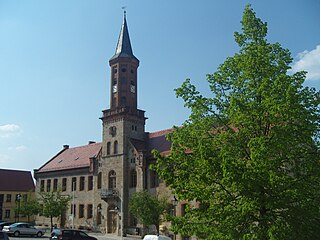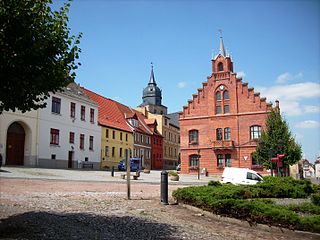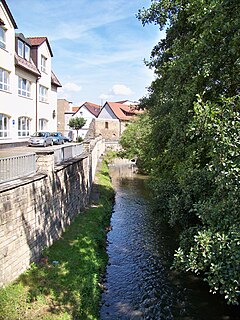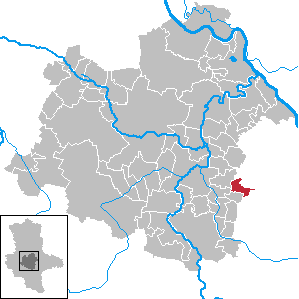
The Saale, also known as the Saxon Saale and Thuringian Saale, is a river in Germany and a left-bank tributary of the Elbe. It is not to be confused with the smaller Franconian Saale, a right-bank tributary of the Main, or the Saale in Lower Saxony, a tributary of the Leine.

Bernburg was a district in Saxony-Anhalt, Germany. It is bounded by the districts of Schönebeck, Köthen, Saalkreis, Mansfelder Land and Aschersleben-Staßfurt.

Bernburg (Saale) is a town in Saxony-Anhalt, Germany, capital of the Salzlandkreis district. The former residence of the Anhalt-Bernburg princes is known for its Renaissance castle.

Nienburg is a town in the district of Salzlandkreis in Saxony-Anhalt, Germany. It is located in the lower Saale valley, approx. 5 km northeast of Bernburg. In January 2010 it absorbed the former municipalities Gerbitz, Latdorf, Neugattersleben, Pobzig and Wedlitz, that became Ortschaften or municipal divisions of the town. In 2020 its population was 6,104.

Könnern (help·info) is a town in the district of Salzlandkreis, in Saxony-Anhalt, Germany. It is situated on the right bank of the river Saale, approx. 15 km south of Bernburg, and 25 km northwest of Halle (Saale).

Saale-Wipper is a Verbandsgemeinde in the district Salzlandkreis, in Saxony-Anhalt, Germany. Before 1 January 2010, it was a Verwaltungsgemeinschaft. It is situated southwest of Bernburg. It is named after the rivers Saale and Wipper, which flow through its territory. The seat of the Verbandsgemeinde is in Güsten.

Alsleben is a town in the district of Salzlandkreis, in Saxony-Anhalt, Germany. It is situated on the river Saale, south of Bernburg. It is part of the Verbandsgemeinde Saale-Wipper.

Güsten is a town in the district of Salzlandkreis, in Saxony-Anhalt, Germany. It is situated on the river Wipper, west of Bernburg. It is part of the Verbandsgemeinde Saale-Wipper. It absorbed the former municipality Amesdorf in January 2010.

The Wipper is a river in Saxony-Anhalt, Germany, a left tributary of the Saale. It is 85 kilometres (53 mi) long. Its name comes from the old German word Uipparaha, which means "singing, bouncing river".

Wilhelm Georg Alexander von Kügelgen was a German portrait and history painter, writer, and chamberlain at the Court of Anhalt-Bernburg. He is best known for his posthumously published memoirs, which have gone through many editions from seventeen different publishers.

Wohlsdorf is an Ortschaft of the town of Bernburg in Salzlandkreis, Saxony-Anhalt, Germany.

Alexius Frederick Christian of Anhalt-Bernburg, was a German prince of the House of Ascania. From 1796 until 1807 he was Reigning prince of the principality of Anhalt-Bernburg, and from 1807 until 1834 the first Duke of the Duchy of Anhalt-Bernburg.
The Nomenclature of Territorial Units for Statistics (NUTS) is a geocode standard for referencing the subdivisions of Germany for statistical purposes. The standard is developed and regulated by the European Union. The NUTS standard is instrumental in delivering the European Union's Structural Funds. The NUTS code for Germany is DE and a hierarchy of three levels is established by Eurostat. Below these is a further levels of geographic organisation - the local administrative unit (LAU). In Germany the LAUs 1 is collective municipalities, and the LAU 2 is municipalities.

The Bundesstraße 6n is a German federal road that runs east-west from the Vienenburg district of Goslar to Bernburg, where it connects to the A14. It was originally planned to be the A 36 motorway. It is intended to have four lanes running from the A 395 near Vienenburg through Wernigerode, Blankenburg, Quedlinburg, Aschersleben over the A 14 to Bernburg (Saale).
The Dessau–Köthen railway connects the cities of Dessau-Roßlau and Köthen in the German state of Saxony-Anhalt. It is one of the oldest lines in Germany and forms the western end of the main line of the Berlin-Anhalt Railway Company. The only passenger services to use the line are regional services.
The Köthen–Aschersleben railway is one of the oldest railway lines in Germany, with its eastern half opened in 1846. It forms an east-west link in the state of Saxony-Anhalt and connects several major towns.

The Mitteldeutsche Zeitung is a regional daily newspaper for southern Saxony-Anhalt, Germany. Published in Halle with several local versions, the paper is owned by M. DuMont Schauberg, Cologne.

The Anhalt University of Applied Sciences is a vocational university with locations in Bernburg (Saale), Dessau-Roßlau and Köthen, Germany.

Bundesautobahn 36 is an autobahn in Germany. It was established on 1 January 2019 from the Bundesautobahn 395 and parts of the Bundesstraße 6.

Christoph Bernstiel is a German politician in the Christian Democratic Union (CDU) who served as a member of the German Bundestag from 2017 to 2021. In addition, he has served on the Halle (Saale) municipal council since 2014.



















